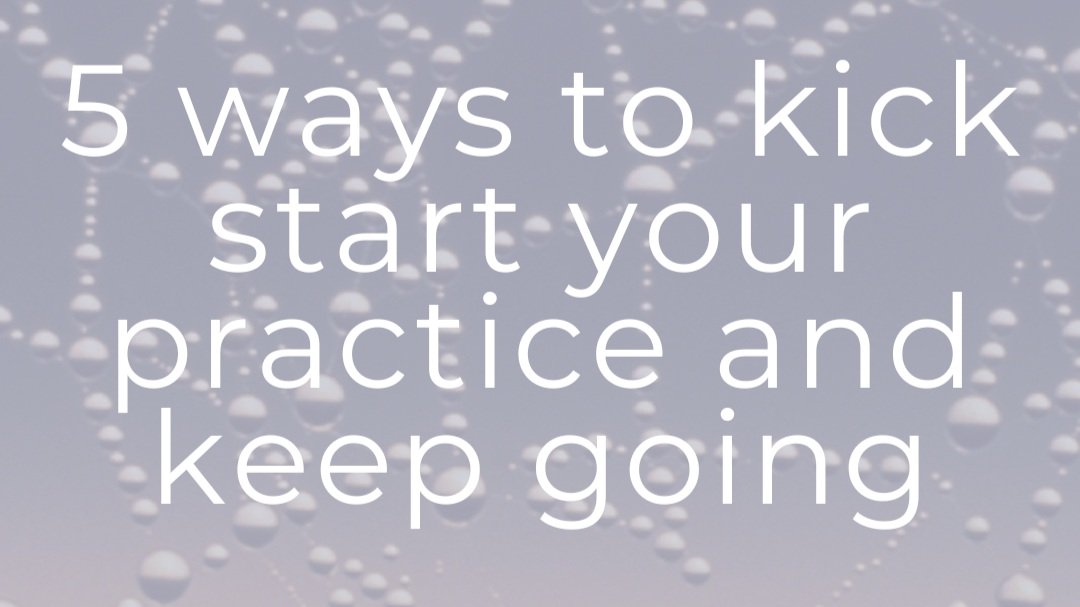5 Ways to Kick-Start Your Ashtanga Yoga Practice and Keep it Going All Year
5 Ways to Kick-Start Your Ashtanga Yoga Practice and Keep it Going All Year
Whether or not you're one for New Year’s resolutions, it’s not uncommon to find yourself feeling sluggish, looking for a reset and a fresh start at this time of year.
With everything that went on last year, it’s not surprising that your yoga practice has fallen by the wayside. You might have found yourself wanting to start back up again but somehow haven't managed to find the motivation to get back on your mat.
If your yoga practice needs a kick-start, and you want to find the motivation to keep it going for the long term, then read on…..
5 ways to kickstart your yoga practice in 2022
Set an intention for how many days a week you’d like to practice
In the Yoga Sutras Patanjali says practice is firmly established when it’s observed over a long period of time without a break (YS 1.14).
Whether you set aside an hour a day or 15 minutes three times a week consistency is key.
Consider how much time you can reasonably allocate to your yoga practice each week. It's important to be realistic with your goals so that you stay motivated throughout the year. You want your practice to be nourishing rather than feel like a chore. If you find yourself wanting to do more you can always increase the frequency or duration of your practice.
If you have other intentions add yoga to the list and put it on display somewhere you’ll see it.
Make a plan to fit yoga into your schedule
Once you’ve set your intention and you know how much time want to dedicate to your yoga practice. The next step is to factor yoga into your schedule.
Identify any classes you’d like to attend and block them out in your calendar. If you plan to practice in the mornings before work, get plenty of sleep the night before. If evening practice is your thing, don’t make plans on the nights you practice yoga. If you’re practising at home choose a time when you’re less likely to be disturbed by anyone you live with.
Maintaining your yoga practice alongside life’s competing priorities requires discipline. In yoga, this discipline is often referred to as “tapas”, the ability to face adversity and continue with yoga both on and off the mat. Ultimately practising yoga gives us the tools to connect with our inner world and this connection helps us navigate life with more peace. Therefore, it's important we make our practice a priority.
Practice with real-life people in your local studio or Yoga Shala
Practising with others is a great way to stay motivated. The energy is completely different in a room with other people. there are fewer distractions so it’s easier to focus and remain present.
When you join a Mysore Ashtanga self-practice group you're also joining a community. You’ll meet people, that you can share your experiences with, motivate each other to practice and even become friends.
The last two years have been tough for everyone. In-person yoga spaces have been struggling and many well-established spaces have had to close their doors. Practising in a shala or yoga studio is a great way to support your favourite teachers or small businesses to ensure they can stick around in the long term.
If you’re practising at home create a practice space
If you live in a City then space is probably limited. Even if you don’t have a dedicated yoga space, you can still create a warm and inviting place to practice.
You might need to move some furniture to make space for your mat. Perhaps run the vacuum cleaner around (crumbs under the sofa can be distracting), light some candles and heat your room so it’s warm.
It’s often easier to focus if the lights are kept low and you remove any distractions, like mobile phones, placing them in another room.
If your space is appealing you’ll find it easier to get on the mat and stay focused once you get there.
If you have an injury modify your practice, rather than stop practicing altogether
Yoga Guru Krishnamacharya said “if you can breathe you can practice yoga”. What he’s referring to is the meditative aspect of practice.
If you have an injury or pain unless you’ve been advised by a Doctor, more often than not it’s possible to continue with your practice, albeit a modified version. This modified version could be anything from a chair-based yoga practice, to a modified Ashtanga or seated breath-based practice.
Stopping practice altogether means you won’t benefit from yoga in your recovery and it will make it harder to get back to practice once you’re feeling better.
An experienced teacher, either in the Mysore room or one to one, will be able to assist you in modifying your practice so that it’s appropriate for the current stage of your recovery.
If you’re looking for a place to practice why not join me at Astanga Yoga London on weekday evenings?


